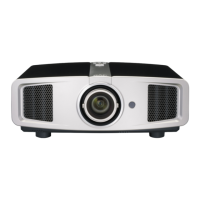tors are now available at prices more
videophiles can afford than ever before.
LCoS was, by reputation, plagued by
both low yields and mediocre contrast,
which resulted in high prices and grayish
blacks.
Sony broke those roadblocks with en-
hanced yields on its SXRD chips, gain-
ing economies of scale by using the chips
in a range of products priced for a wide
market. Sony also engineered the most
effective dynamic irises in the industry,
dramatically lowering black levels.
JVC, however, has been in the business
of producing LCoS video displays longer
than anyone, and has clearly now been
able to lower costs and increase yields as
well. For these new projectors, JVC has
designed both a brand new D-ILA chip
and an improved light engine. The new
0.7-inch, 1920x1080 D-ILA chip em-
ployed here is spec’d for a chip-level con-
trast ratio of 20,000:1. This is made
possible by a major reduction in the
crossover of stray light between the pix-
els. The projector overall, including the
chips, light engine, and optics, is specified
to have a native contrast ratio of
15,000:1.
At present JVC is using this new D-
ILA chip and optical engine only in
these two new front projectors. The new
components are not yet employed in any
of the company’s more expensive projec-
tors or in the highly tweaked versions of
those projectors that are available from
Meridian/Faroudja. But I would not be
surprised to see one or both new devel-
opments turn up in future JVC products.
The improved black level in these new
projectors has come exclusively from the
new chip and light engine. They have no
iris of any kind, fixed or dynamic. The
only control over light output, apart from
the Contrast control, is a two-position
brightness adjustment for the 200W
UHP mercury lamp. The High position
of the lamp is about 20% brighter than
the Normal position.
Zoom and focus are manual, as are both
horizontal and vertical lens shift. The lens
has a fairly long throw; for a 100” diago-
nal image (87” wide 16:9 screen) the
projector may be set up anywhere be-
tween 9.9- and 19.9-feet.
The DLA-HD1 provides one input
each for component, composite, and S-
Video, plus two HDMI 1.2 ports. There
is also an RS-232 (9-pin D-sub) termi-
nal.
Operating controls are located on the
top of the case, but every control you’ll
need is also available on JVC’s well-de-
signed remote. The remote offers direct
input selection and direct access to a
number of frequently used functions, in-
cluding Brightness, Contrast, Color,
Sharpness, and six different Image Pro-
files: Cinema, Natural, Dynamic, and
User 1,2, and 3. While the video adjust-
ments are global across all inputs (you
can’t set in different values for different
inputs) you can set up different profiles
that cover a wide range of video adjus-
ments and use these for different inputs.
In addition to the option to configure
each of the three User settings, you can
also alter the factory settings for the Cin-
ema, Natural, and Dynamic profiles as
well.
There are five Color Temp. selections:
Low, Middle, High, User 1, and User 2.
Both User settings provide separately ad-
justable overall Red, Green, and Blue ad-
justments, but do not offer control for
<BOTH< I>the top and bottom of the
brightness range.
The same color temperature control limita-
tions apply to the code-locked Service menu, so
there is no particular advantage for a calibra-
tion technician to go there unless you want to
recalibrate the Low, Middle, and High factory
default settings. The latter do not offer user ac-
cessible Red, Green and Blue controls. But a
separate set of Red, Green, and Blue controls
in the user menu, called”Offset,” allow you to
tweak the five Color Temp. options.
But the Offsets are global—you can’t set
them separately for each of the Color Temp.
choices. My recommendation for those who
choose to calibrate the projector (which I recom-
mend) is to first make certain that the Offsets
are set to zero, then perform the calibration
using one or both of the User settings. For se-
curity against someone changing the calibrated
settings, write them down. After that, leave the
Offsets alone unless you find a program with
obviously whacked-out color, such as too-green
flesh tones. In that case, use the Offsets for
very fine adjustments, carefully returning them
to zero for better-produced programming.
The projector does not offer a manual selec-
tion (or an auto switchover, as far as we can
determine) between the NTSC color space
(REC601) and ATSC color space
(REC709 for DTV/HDTV). Since the
specifications do not mention the ATSC color
system at all, and our test tools cannot check
for this, I have to assume that the projector
ultimateAV

